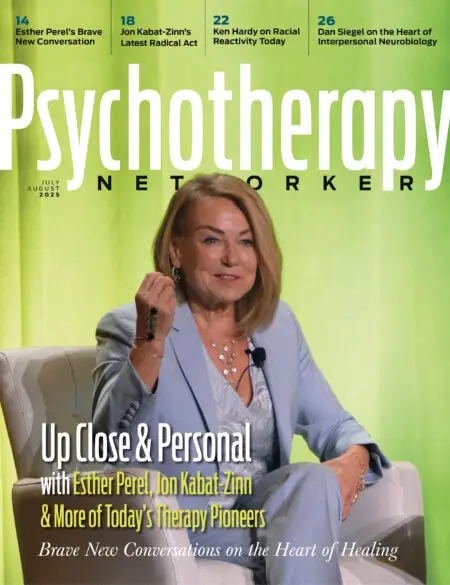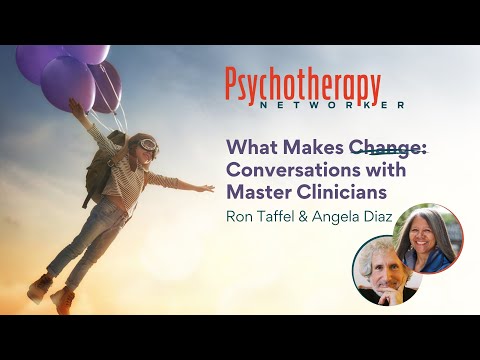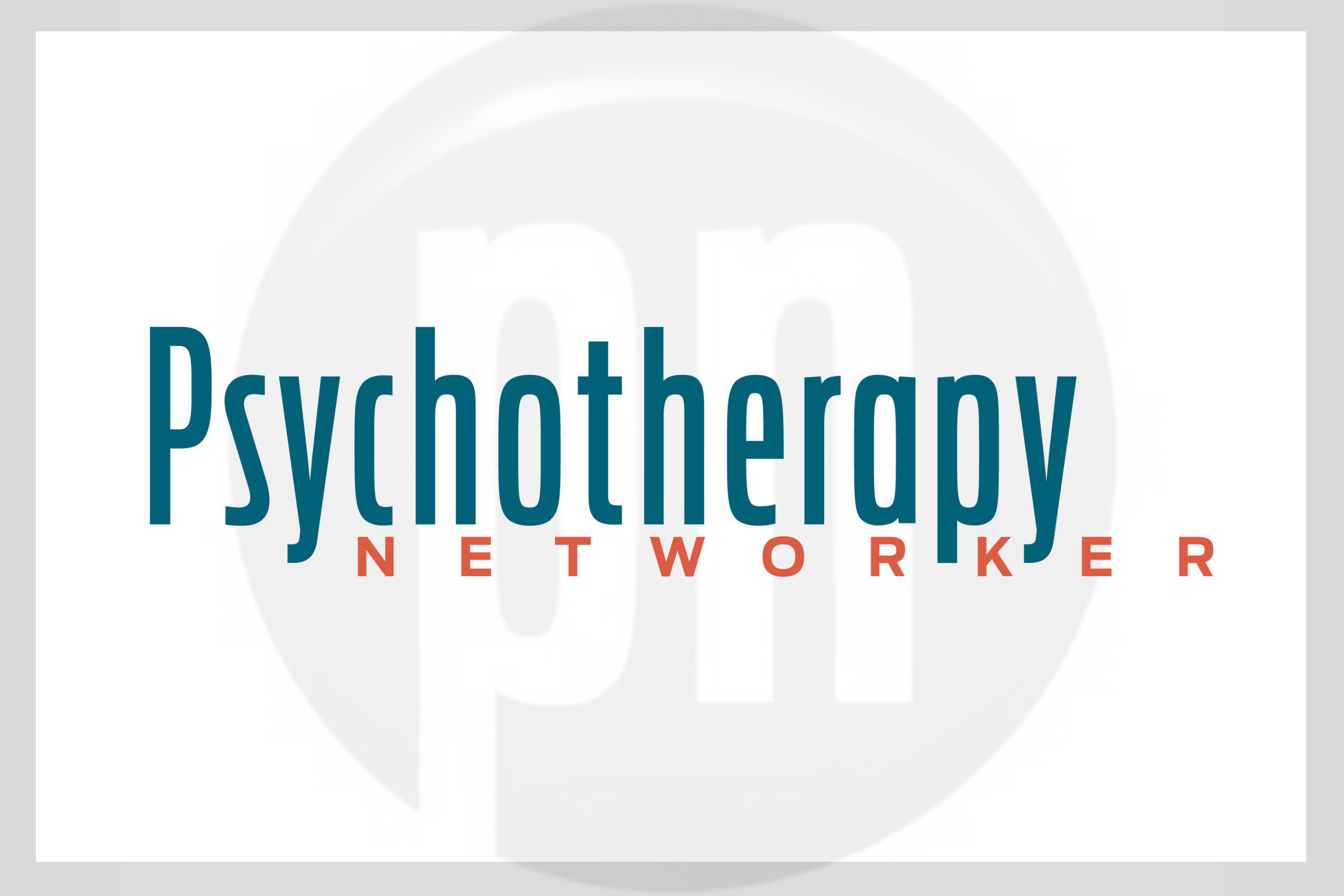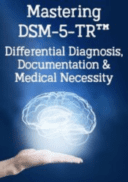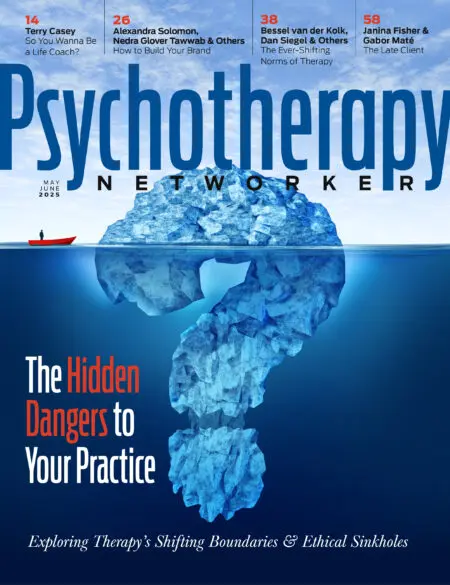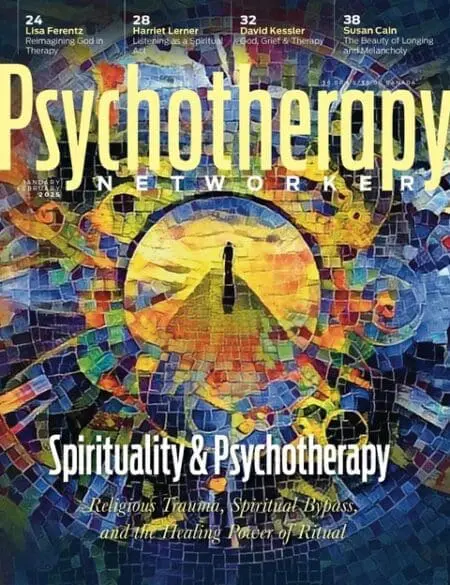Q: Help! My client gets overwhelmed when we try to address anything related to her trauma. What can I do that will work?
A: One potent, practical tool all therapists can add to their clinical repertoire when doing trauma work is tapping. Because tapping isn’t always well understood, some people have relegated it to the woo-woo realm, but it’s evidence based and can be helpful to clients, particularly those with complex trauma. Although it’s central to popular therapeutic practices, such as Emotional Freedom Technique (EFT) and eye-movement and desensitization reprocessing (EMDR) therapy, all mental health professionals can learn it quickly, integrating it into whatever therapeutic framework they use to guide sessions.
As an EMDR, Internal Family Systems (IFS), and transpersonal therapist specializing in trauma, I’ve spent the last 12 years working with clients suffering from PTSD, complex trauma, eating disorders, anxiety, and more. I’ve found that tapping offers an effective, experiential, somatic pathway for calming the nervous system, so clients can learn to regulate their emotions and build internal resources, like having greater access to self-energy (a concept drawn from IFS), confidence, compassion, insight, presence, and intimacy.
My passion for these techniques comes from seeing how effective they were in my own life. In the early 2000s, during a painful time when I was grieving the loss of my grandmother and transitioning my career from human-resources management into mental health counseling, my therapist taught me tapping. She explained that it could help me decrease my anxiety and connect with my emotions and needs. She helped me create a powerful affirmative statement to use while tapping and demonstrated the tapping sequence on herself.
After our session, I went home, lay down on my couch with my beloved dog, and tried it. For half an hour, I tapped the same places on my head, face, and torso that my therapist had indicated were part of the standard tapping protocol pathway. At the same time, I repeated the following affirmation to myself: “Even though I feel anxious in my body, I can learn to deeply love and accept myself.”
I was surprised at how I felt afterward. My resistance to the anxiety had lessened, and I felt more peaceful and self-accepting. After that, I practiced tapping most days and took workshops and trainings to deepen my knowledge. One of my favorites was a powerful workshop on meridian tapping and other energy techniques taught by David Feinstein and his wife, Donna Eden.
Sometimes I tapped to settle my nervous system. Sometimes, I focused on a negative emotion or symptom I was struggling with while I tapped and adapted my statements to help me work through challenging internal experiences, like grief, frustration, and fear. The practice had a radically positive effect on my well-being.
Over the years, I’ve discovered the value of tapping as a free-standing, independent tool, which empowers clients in different types of therapy. Clients can use it safely and easily in their everyday lives outside of sessions. It can be surprisingly enjoyable and fun—similar to, in my view, finishing a yoga class in Savasana, humming a favorite song, or giving yourself a foot massage after a long hike. The act of tapping communicates to our nervous systems, in a specific, embodied way, that we are held, cared for, and safe.
Three Ways to Tap
Resource-based tapping techniques include resource tapping (also known as tapping in), resource development installation (RDI), and meridian tapping.
Resource tapping is a powerful technique, developed by Laurel Parnell to do what she calls “tapping-in imaginary nurturing, wise, and protective figures and experiences.” Although all of us can benefit from it, it’s especially powerful and crucial for clients who have attachment trauma and were brought up in dysfunctional households. Coupled with the technique of bilateral stimulation (BLS)—which activates and crosses over both brain hemispheres and was developed as a central part of EMDR therapy by Francine Shapiro in the 1980s—resource tapping can help give clients a felt sense of being nurtured and cared for. Although BLS is used for more than resourcing in EMDR therapy—as for desensitization and trauma reprocessing—non-EMDR therapists trained in tapping sometimes combine elements of both techniques when helping resource clients by tapping on their shoulders or knees in a rhythmic, left-right sequence.
RDI is another powerful technique stemming from EMDR therapy, created by Andrew Leeds and Deborah Korn, and later adapted by Janina Fisher and others. It focuses on the use of BLS and tapping to instill positive affect, build distress tolerance, and develop internal resources for clients with severe symptomatology. An example of this would be guiding your clients to imagine embodying the strength and courage to speak and advocate for themselves in challenging situations. Through the imagination, clients can envision a scenario where they’re courageous and strong, and then embody and amplify an internal sense of this experience, or instill it neurobiologically by tapping it in.
Meridian tapping refers to the tapping or massaging of acupoints—used in Chinese medicine and acupuncture. These points run along the entire body; however, we generally tap only at the beginning or end of a meridian pathway. The basic tapping technique found in EFT is pretty straightforward. It involves—you guessed it—tapping different parts of your face and body with your index, middle, and pointer fingers while reciting statements meant to address negative symptoms and underlying emotions. In EFT, it’s called meridian tapping because it uses the fingers to tap on bodily locations where, in Chinese medicine, chi, or lifeforce energy, is thought to flow.
You don’t have to believe in ancient healing practices to benefit from tapping. We can all diminish our stress responses and feel safer by activating certain acupressure points. When we do this while reciting an empowering statement, there’s even more healing potential. It can create a parasympathetic response, help regulate our emotions, and reduce cortisol levels in the body. Findings from a 2022 clinical trial that analyzed fMRI findings, published in Science Direct, demonstrated that tapping works on a neural level, changing brain activity in regions involved in pain modulation. A 2019 study published in the Journal of Evidence-Based Integrative Medicine concluded that tapping induced significant neural changes in the emotional processing of anxiety, depression, pain, and cravings, and increased well-being.
Creating the Statement
When tapping, clients speak affirming statements tailored to the underlying emotional needs of a particular situation. Initially, they may struggle to form their statements, so it’s helpful to take time in session to guide them in the process of structuring effective and meaningful statements, highlighting an unpleasant or unwanted symptom, such as anxiety. In EFT, a common statement used with tapping is “Even though I’m scared, I love and accept myself exactly as I am.” The best statements are specific, meaningful, in the client’s words, and believable. By naming and accepting an unwanted symptom while going through the tapping sequence, your body, brain, and nervous system can gently release stuck fight-or-flight sympathetic responses by calming the amygdala.
The first part of a tapping statement—“Even though I [feel, think, have, or am] [emotion, issue, condition, or symptom]”—identifies what is being addressed, setting the focus and intention, as well as allowing the client mindfully to name and observe what is being worked on. The second half affirms a desired state of being, setting the intention for self-acceptance, compassion, and meaningful change. Accompanying short affirmative phrases can be used after tapping out the full statements, such as “I’m okay as I am,” “I stand in my truth,” or “I’m worthy of love.” Tapping the specific points on the head, face, and body is done while repeating the statement or a phrase—which helps release blockages and instill calm.
My client Hannah was a 48-year-old self-employed single mother with a complex trauma history who’d just gone through a complicated divorce. When she first came to see me, she was struggling with intense anxiety. We used tapping to develop and enhance positive self-states, such as compassion, courage, curiosity, calm, clarity, creativity, connectedness, and confidence. Once accessed, Hannah was able to use self-energy states of creativity, courage, and self-compassion to regulate her emotions and balance her nervous system when she felt jittery, anxious, or overwhelmed.
During one session, as Hannah spoke about feeling like a failure, I gently said, “We can keep talking about your feelings, or we can do something different—something you can practice between sessions to reduce your anxiety. Want to try it?” She looked a bit apprehensive, so I proceeded to let her know more. “The technique is called EFT tapping. It involves activating certain pressure points in a particular sequence while you speak an affirmation. It’s been well-researched, and it’s easy to do and effective.”
Hannah agreed to try it. Despite her initial skepticism, she found it soothing and grounding. First, we settled on a statement that felt right to her: “Even though I’m overwhelmed with feelings of inadequacy, I’m learning to love and accept myself.” Then, I invited her to tap her head, face, neck, chest, and the side of her body in sequence—following my lead—as she gently repeated her statement. By the time we finished, her face had visibly relaxed, and she began laughing. “Wow,” Hannah said. “It’s like a weight has lifted. I can breathe deeper. I had no idea I wasn’t breathing deeply before.”
In one memorable session, she told me, “I used the tapping at home when I felt hurt by something my son said, and it changed my whole mood and perspective. I was able to reconnect with him afterward, and then I introduced him to tapping. He added a funny statement: ‘Even though we’re a freaky family, we’re really cool,’ and we laughed and tapped together. It was great. Tapping sounded a bit weird when you told me about it,” Hannah admitted, “but now I like doing it.”

I wish more therapists knew about tapping, not only to benefit their clients, but also for themselves. Sometimes, between clients, I’ll run through a tapping sequence, using the statement “Even though I’m experiencing doubts about my last session, I love and accept myself as a person and a therapist.” Tapping helps me make peace with the inevitable ups and downs, not only of daily living, but of the unpredictable and rewarding work of psychotherapy.
Photo Credit: Microgen/iStock
Stacy Ruse
Stacy Ruse, LPC, is an Evergreen EMDR Consultant & IFS-Institute Consultant who owns Aglow Counseling, where she offers training, clinical consultation, and counseling to therapists and healers. She’s a trauma expert who combines trauma-informed therapies, such as EMDR and IFS, with a transpersonal twist and the art of Presence in her work.
